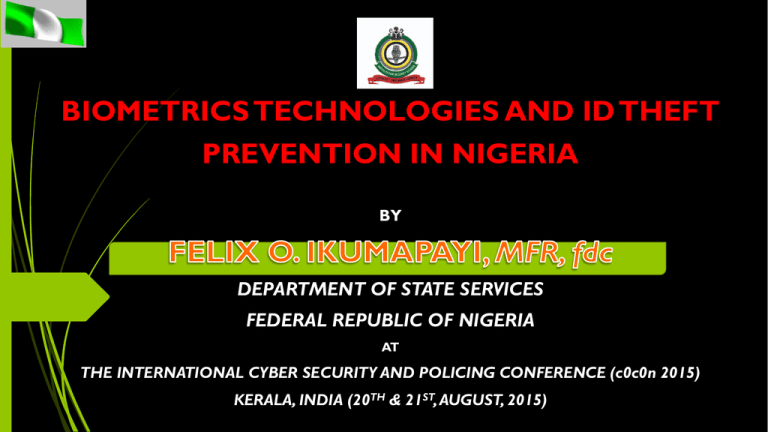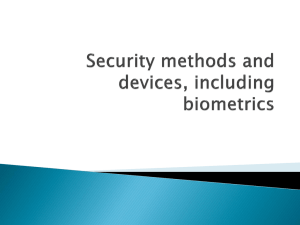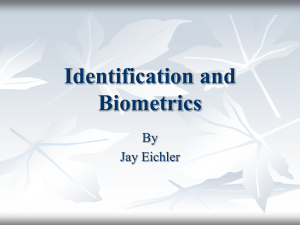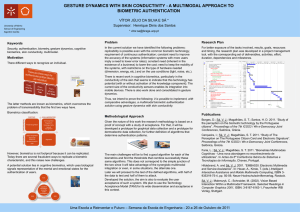BENEFITS OF BIOMETRICS TECHNOLOGIES
advertisement

BIOMETRICS TECHNOLOGIES AND ID THEFT PREVENTION IN NIGERIA BY DEPARTMENT OF STATE SERVICES FEDERAL REPUBLIC OF NIGERIA AT THE INTERNATIONAL CYBER SECURITY AND POLICING CONFERENCE (c0c0n 2015) KERALA, INDIA (20TH & 21ST, AUGUST, 2015) ORDER OF PRESENTATION 2 Introduction Important Characteristics of Biometrics Technologies Types of Biometrics Some Biometrics Technologies Benefits of Biometrics Technologies Concerns Over the Application of Biometrics Technologies by Stakeholders Combating ID Theft (Nigeria) Enactment of the Nigeria Cybercrime Act 2015 Suggestions Conclusion 3 4 INTRODUCTION Every human being has some intrinsic physical or behavioral characteristics that are peculiar to him or her. A typical example is fingerprints which are permanent and different for each individual. It has been established that even identical twins do not have identical fingerprints. INTRODUCTION (Cont’d...) 5 Technology, in the name of biometrics, is now taking advantage of these measurable biological characteristics or traits of human beings to develop systems that automatically identify people uniquely. The uniqueness of identification that biometrics provides is making the latter a useful tool in transaction and secure processing systems where trust is of utmost importance. . www.google.com/images 6 INTRODUCTION (Cont’d...) Biometrics can be used in almost any application that requires the accurate identification of an individual. This ranges from computers, where a fingerprint scan on the keyboard can verify the identity of a user, to nuclear power plants where various biometrics are used to restrict access to critical systems. RESTRICTED 7 INTRODUCTION (Cont’d...) In Nigeria, Patent fingerprinting constitutes the core of biometric authentication systems used in such areas as Voters' Registration, National Identity Cards, Electronic Passports, Banking transactions and Access Control, among others. RESTRICTED www.google.com/images 8 INTRODUCTION (Cont’d...) Though the early adoption of biometrics was centred mainly on fingerprints, attention is currently shifting to incorporate other human physical characteristics such as face, iris, palm, voice, etc. www.google.com/images 9 10 IMPORTANT CHARACTERISTICS In determining the suitability of biometric technologies, the following factors or characteristics should be considered and evaluated: Universality. Uniqueness. Permanence. Collectability. Performance. Acceptability. Circumvention. www.google.com/images 11 12 TYPES OF BIOMETRICS Chemical Biometrics – These are genetic characteristics found in a person’s blood or other related segments. An example of chemical biometrics is the Deoxyribonucleic Acid (DNA) matching.This is the identification of an individual using the analysis of segments from DNA. www.google.com/images 13 TYPES OF BIOMETRICS (Cont’d...) Physiological Biometric – These are characteristics found in a person’s palm, fingers, iris and voice, as shown in the examples below: Ear. Eyes: Iris Recognition Eyes: Retina Recognition Face Recognition. Fingerprint Recognition. www.google.com/images 14 TYPES OF BIOMETRICS (Cont’d...) PHYSIOLOGICAL/SPATIAL BIOMETRICS FINGER GEOMETRY RECOGNITION. HAND GEOMETRY RECOGNITION www.google.com/images 15 TYPES OF BIOMETRICS (Cont’d...) Behavioral Biometrics – These are characteristics found in a person’s handwriting or keyboard keystrokes. Examples include: GAIT. TYPING RECOGNITION. Physiological/Behavioural Biometric SIGNATURE RECOGNITION The authentication of an individual by the analysis of handwriting style, in particular the signature. www.google.com/images 16 17 SOME BIOMETRICS TECHNOLOGIES SIGNATURE VERIFICATION HAND & FINGER GEOMETRY FACE RECOGNITION DEVICE IRIS SCANNING DEVICE www.google.com/images 18 BENEFITS OF BIOMETRICS TECHNOLOGIES 19 Below are among the numerous benefits of biometrics application: Biometrics provides suitable applications for improving airport security, strengthening national borders, in travel documents, visas and in preventing ID theft. Biometrics is gradually becoming socially acceptable and inexpensive in some cases. The promises of e-commerce and e-government can be achieved through the utilization of strong personal authentication procedures. Secure electronic banking, investments and other financial transactions, retail sales, health and social services are already benefiting from these technologies. BENEFITS OF BIOMETRICS TECHNOLOGIES 20 (Cont’d…) Biometrics can be used to identify you as you. Most biometrics technologies are "user-friendly". The biometrics initiative will assist law enforcement agencies in making easy headway in fraud investigations and prosecution and in bringing cases of fraud in the banking sector to the barest minimum. RESTRICTED 21 BENEFITS OF BIOMETRICS TECHNOLOGIES (Cont’d…) Biometrics technologies have also been found to be useful in enterprises and Government networks, passport programs and driver licenses, colleges, physical access to multiple facilities (e.g., nightclubs) and school programs, etc. RESTRICTED www.google.com/images 22 23 CONCERNS OVER APPLICATION OF BIOMETRICS TECHNOLOGIES Despite the numerous benefits of biometrics technologies, obstacles to immediate and successful deployment still linger in many parts of the world. Below are amongst the major concerns: INVASION OF PRIVACY. ERROR RATE. RELATIVE HIGH COST. INSUFFICIENT OPERATIONAL SKILLS. www.google.com/images 24 RESTRICTED COMBATING ID THEFT IN NIGERIA 25 One of the initial major obstacles to the introduction of biometrics technologies in Nigeria, was the absence of a unified national database for the over 150 million people. www.google.com/images RESTRICTED RESTRICTED 26 COMBATING ID THEFT IN NIGERIA (Cont’d…) As a result of this, the Nigerian Government through the National Identity Management Commission (NIMC) boosted the nation’s Automated Biometrics Identification System (ABIS) in 2013, ranking its capacity as the largest in SubSaharan Africa. www.nimc.gov.ng/images RESTRICTED 27 COMBATING ID THEFT IN NIGERIA (Cont’d…) With the upgrade in capacity, efforts are being intensified by the Commission to process and harmonize large volume of identity databases existing in other government agencies, such as the Independent National Electoral Commission (INEC) and the Nigerian Communications Commission (NCC). www.inecnigeria.org www.ncc.gov.ng 28 29 BANKING SECTORS In 2014, the Central Bank of Nigeria (CBN), through the Banker’s Committee, an umbrella body of Deposit Commercial Banks, in collaboration with all banks in Nigeria launched a centralized Biometrics Identification System for the industry, tagged: Bank Verification Number (BVN). www.cbn.gov.ng/images 30 FEDERAL CIVIL SERVICE The Nigerian Government in 2012 directed all its Ministries, Departments and Agencies (MDAs) to institute a biometric verification system for all civil servants in its employment in an effort to provide the government with an accurate record of its personnel, as well as a means of cleaning up its payroll. The data, so far gathered from the biometrics process have assisted the government in saving billions of Naira spent monthly on ‘ghost’ or unidentifiable civil servants. 31 ELECTIONEERING PROCESS The use of biometric technologies, Fingerprint Identification Readers or (Voters’ Data Capturing Machines) to validate voter ID cards in the conduct of 2015 general elections in Nigeria added some level of credibility, civility and contributed to the first relatively safe and successful elections in the country’s history. www.inecnigeria.org/images 32 NATIONAL CENSUS Over-politicization has been the bane of Nigeria’s previous census exercises. Census is erroneously viewed by many as a basis for resource allocation and other expected national benefits to regions or States. This accounts for the quest to compromise the process. Biometric technology is however, being introduced as a means of checking the undue politicization and ensuring unbiased, accurate and easy to analyze data in the proposed national census, slated for 2016. RESTRICTED 33 ENACTMENT OF THE NIGERIAN CYBERCRIME ACT, 2015 In a bid to support the growth of biometrics technologies and to check the growing excesses of criminal activities associated with ID theft in particular, the Nigerian Legislature successfully enacted the nation’s Cybercrime Act.The Act was passed into law in May, 2015. www.google.com/images 34 35 SUGGESTIONS Based on the foregoing, the following suggestions are proffered to support Nigeria’s quest for increased application of biometrics technologies in addition to efforts at combating ID theft and other cybercrime related offences: i. Technical support from relevant stakeholders in the international community, especially in the training of Nigerians on the required expertise in the maintenance and operations of some relatively complex biometrics technologies. 36 SUGGESTIONS (Cont’d…) ii. The need to harmonize and strengthen international laws against ID theft and cybercrime, considering the dynamic and trans-border nature of these criminal activities. iii. The need to sustain international fora, such as c0c0n Conferences, to provide platforms for cross fertilization of experiences among global stakeholders, with a view to being ahead of cyber fraudsters and their fraudulent acts. 37 CONCLUSION 38 Amidst the disturbing rise in computer related crimes, biometrics technologies provide a veritable option to combate these menaces. The growing acceptance of these technologies in adding value to different sectors of the society is a global testimony to its efficacy. Just like the revolution of telecommunication sub-sector, biometrics technologies are set to revitalize critical aspects of human endeavour. CONCLUSION (CONT’D…) 39 As shown by this presentation, Nigeria is a country that is embracing biometric technology at an encouraging rate. The country has been aggressively pursuing strong authentication solutions for a wide variety of applications not only to reduce bias, fraud and corruption, but with the goal of becoming one of the leading world economies by the year 2020. 40 41 REFERENCES Counter, PB. ‘National ID: Nigeria to Use Biometrics in National Census’. An online article published by findbiometrics.com (May, 2014). Email Sample: www.biometricsinstitute.org. ‘About Biometrics’. An Online Resource Library of the London Biometrics Institute, 2015. Folami, Nkoyock, etal. ‘Political Leadership Issues In Africa: Lessons Learned From The 2015 Nigerian Presidential Election’. Another perspective on Leadership, Development, and New Technologies, July, 2015. Homeland Security. ‘Biometrics Overview’. An online publication by Global Security.org. Nigerian Cybercrimes (Prohibition, Prevention, Etc) Act, 2015 Nwannenna, C C. ‘The Place For Biometrics Technology In Local Content Development’: condatasystems@live.com 42 REFERENCES (Cont’d…) Obi Paul. ‘NPC Insists on Biometrics Satellite to Conduct 2016 Census’. An editorial published on ThisDay Newspapers, May, 2015. ThisDayLive. ‘Biometrics for Banks’. An Editorial Column published by ThisDay Newspapers, March, 2015. Zeg Zegiorgis. ‘Biometric Technology Stomps Identity Theft’. As part of the Information Security Reading Room. SANS Institute, 2002.





